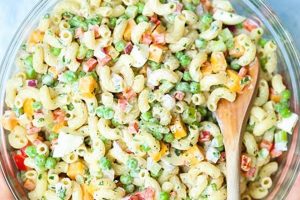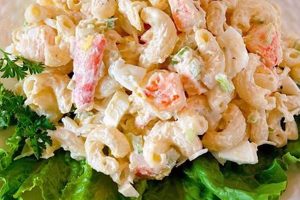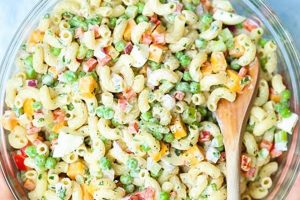This dish, a staple at Filipino gatherings and celebrations, typically features cooked elbow macaroni, a creamy dressing often based on mayonnaise, and a variety of additions. Common ingredients include shredded chicken, chopped hot dogs, carrots, raisins, and sweet pickle relish. The dish offers a unique blend of sweet, savory, and tangy flavors, contributing to its widespread popularity.
Its presence at nearly every Filipino fiesta reflects its cultural significance as a symbol of celebration and community. Adaptable and relatively inexpensive to make, this salad serves as both a comforting everyday meal and a festive dish suitable for special occasions. Its evolution from a simple macaroni salad reflects Filipino culinary creativity in adapting and incorporating influences from other cultures.
Further exploration will cover variations on traditional preparations, including vegan and healthier options, regional differences in ingredients and methods, tips for achieving the perfect texture and flavor balance, and suggestions for presenting and serving this beloved dish.
Tips for Perfect Macaroni Salad
Achieving the ideal texture and flavor profile requires attention to several key steps.
Tip 1: Cook the pasta al dente. Overcooked macaroni results in a mushy salad. Aim for a firm texture by slightly undercooking the pasta according to package directions.
Tip 2: Chill all ingredients thoroughly. Cold ingredients ensure food safety and contribute to a refreshing final product. Chill the cooked macaroni, vegetables, and protein components before combining.
Tip 3: Use high-quality mayonnaise. The mayonnaise serves as the base of the dressing; its quality significantly impacts the overall flavor. Opt for a brand known for its rich and creamy texture.
Tip 4: Balance sweetness and tanginess. The characteristic sweet-savory-tangy balance is crucial. Adjust the amounts of sugar, pickle relish, and other ingredients to achieve the desired flavor profile.
Tip 5: Incorporate a variety of textures. The interplay of textures enhances the eating experience. Combine soft elements like macaroni and shredded chicken with crunchy vegetables like carrots and celery.
Tip 6: Do not overmix. Overmixing can damage the ingredients and create a less appealing texture. Gently combine the ingredients until just incorporated.
Tip 7: Allow flavors to meld. Refrigerate the salad for at least an hour before serving. This allows the flavors to meld and develop fully.
By following these tips, one can create a macaroni salad with optimal texture, flavor, and visual appeal.
In conclusion, preparing this dish involves more than simply combining ingredients; it requires an understanding of the subtle nuances that elevate it from ordinary to extraordinary.
1. Ingredients
Ingredient selection significantly influences the final flavor profile and texture of Pinoy macaroni salad. Understanding the role of each component allows for informed substitutions and adjustments to cater to individual preferences and dietary needs. The following facets illustrate the importance of ingredient choices.
- The Base: Macaroni and Dressing
Elbow macaroni provides the foundation. Its shape holds the creamy dressing effectively. While traditional recipes use mayonnaise, variations incorporate evaporated milk or all-purpose cream for a lighter texture. The quality of the mayonnaise directly impacts the overall richness and flavor.
- Protein and Flavor Enhancers
Shredded chicken or chopped hot dogs are common additions, providing protein and savory notes. Some recipes incorporate ham, tuna, or even corned beef. These additions contribute to a more substantial and flavorful salad.
- Sweet and Tangy Elements
Sweet pickle relish introduces a tangy complexity, balancing the richness of the mayonnaise. The addition of sugar or condensed milk further enhances sweetness. These contrasting flavors create the characteristic sweet-savory-tangy balance of the dish.
- Textural Variety: Vegetables and Add-ins
Carrots, celery, onions, and bell peppers offer textural contrast to the soft macaroni and protein. Raisins and pineapple tidbits provide bursts of sweetness and chewiness. These additions create a more dynamic and engaging sensory experience.
The careful selection and balance of these ingredients are essential for creating an authentic and satisfying Pinoy macaroni salad. Variations in ingredient choices allow for personalization while maintaining the fundamental characteristics of this beloved dish.
2. Preparation Methods
Preparation methods significantly influence the final quality and character of Pinoy macaroni salad. While seemingly straightforward, specific techniques contribute to the desired texture, flavor development, and overall appeal. Careful attention to these methods distinguishes an exceptional salad from a mediocre one. The cooking of the pasta, for example, directly impacts the final texture. Overcooking results in a mushy, unappetizing salad, while undercooking leads to a firm, desirable texture. Cooling the ingredients thoroughly before combining prevents bacterial growth and ensures a refreshing final product. This cooling period also allows the flavors to meld and deepen. Furthermore, gentle mixing prevents the breakdown of delicate ingredients, maintaining the desired texture and visual appeal. Rushing these steps can compromise the overall quality of the final dish. For instance, adding warm pasta to the mayonnaise-based dressing can cause it to separate, resulting in an oily, less palatable salad. Similarly, neglecting to chill the ingredients thoroughly can lead to a less refreshing and potentially unsafe final product.
A crucial element in Pinoy macaroni salad preparation involves balancing flavors. The hallmark of this dish lies in the delicate interplay of sweet, savory, and tangy notes. Achieving this balance necessitates careful consideration of ingredient proportions. Adding excessive sugar or condensed milk can result in an overly sweet salad, masking the other flavors. Conversely, insufficient amounts of these ingredients can lead to a bland, less satisfying dish. Likewise, the amount of pickle relish influences the tanginess level; adjusting this component allows for personalized flavor profiles. The timing of ingredient incorporation also plays a role. Adding certain ingredients too early, like delicate fruits, can cause them to break down during mixing, compromising both texture and visual appeal. Conversely, delaying the addition of certain spices or seasonings might hinder their ability to fully permeate the other components, leading to a less well-developed flavor profile. These seemingly minor details can significantly impact the final result, demonstrating the importance of adhering to established preparation methods.
Mastery of preparation methods elevates Pinoy macaroni salad from a simple combination of ingredients to a culinary expression. Understanding the rationale behind each step ensures consistent results and allows for informed adjustments based on individual preferences. This knowledge ultimately empowers individuals to create a truly exceptional and personalized version of this beloved dish, reflecting both culinary skill and an appreciation for the nuances of Filipino cuisine.
3. Cultural Significance
The prevalence of this dish within Filipino culture transcends its role as mere sustenance; it embodies a deeper connection to communal values and historical influences. Its presence at virtually every Filipino gathering, from casual potlucks to grand celebrations like weddings and birthdays, signifies its integral role in social bonding and festive traditions. This shared culinary experience fosters a sense of belonging and reinforces cultural identity. The affordability and adaptability of the recipe further contribute to its widespread popularity, making it accessible to individuals across various socioeconomic backgrounds. This inclusivity strengthens its position as a unifying element within Filipino communities worldwide. Historical context reveals potential influences from Western cuisine, particularly American culinary traditions, reflecting the Philippines’ complex history. The adaptation and localization of macaroni salad demonstrate Filipino resourcefulness and culinary creativity, transforming a foreign concept into a distinctly Filipino dish.
The dish often serves as a tangible link to family heritage and personal memories. Many Filipinos associate it with specific family gatherings, holidays, or childhood experiences, imbuing the dish with emotional significance. This nostalgic connection reinforces the cultural transmission of culinary traditions across generations, ensuring the continued presence of the dish within Filipino households. Furthermore, the communal nature of preparing and sharing this salad often involves multiple family members contributing to the process, further strengthening family bonds and reinforcing cultural values. This collaborative effort highlights the importance of shared responsibility and collective enjoyment within Filipino culture. The dish’s adaptability extends beyond basic ingredients; it accommodates regional variations and personal preferences, reflecting the diverse culinary landscape within the Philippines. These regional adaptations often incorporate local ingredients and flavors, further highlighting the dish’s ability to represent and celebrate regional identities.
Understanding the cultural significance of this dish provides valuable insight into Filipino values and traditions. It demonstrates the importance of food as a vehicle for social interaction, cultural expression, and historical preservation. This knowledge enriches the culinary experience, transforming a simple salad into a symbol of Filipino identity and heritage. Recognizing this cultural significance fosters appreciation for the intricate ways food intertwines with community, family, and history within Filipino culture. Moreover, this understanding promotes cross-cultural awareness and appreciation, highlighting the power of food to connect people and transcend cultural boundaries.
4. Variations
Variations within this dish demonstrate the adaptability of Filipino cuisine and its responsiveness to individual preferences and available resources. These adaptations, while maintaining the fundamental elements of the dish, introduce diverse flavors and textures, enriching the culinary experience and reflecting regional and personal influences. The core componentsmacaroni, a creamy dressing, and a blend of sweet, savory, and tangy elementsremain consistent, providing a familiar foundation upon which variations are built. For instance, the addition of shredded chicken or chopped hot dogs introduces a savory protein element, increasing the dish’s heartiness. Incorporating ingredients like pineapple chunks or raisins provides bursts of sweetness and textural contrast. These variations cater to diverse palates while upholding the dish’s essential character. Furthermore, regional variations often incorporate locally available ingredients, reflecting the diverse culinary landscape of the Philippines. The use of specific fruits, vegetables, or protein sources unique to a particular region highlights the dish’s ability to adapt and represent local culinary traditions.
The flexibility inherent within the recipes allows for creative expression and personalized interpretations. Dietary restrictions can be accommodated through ingredient substitutions. For example, vegan versions utilize plant-based mayonnaise and omit meat products, expanding accessibility and inclusivity. Healthier variations might emphasize reduced-fat mayonnaise, increased vegetable content, and alternative sweeteners. These modifications cater to specific dietary needs without compromising the dish’s fundamental appeal. Furthermore, the variations reflect resourcefulness and adaptability. In regions with limited access to certain ingredients, substitutions are made with readily available alternatives. This resourcefulness highlights the dish’s ability to transcend economic limitations and remain a culinary staple across diverse communities. The variations, therefore, not only enhance the culinary experience but also serve as a testament to Filipino ingenuity and adaptability in the kitchen.
Ultimately, the variations within this dish underscore its enduring appeal and cultural significance. They represent a balance between tradition and innovation, honoring the dish’s core elements while embracing individual creativity and regional diversity. This adaptability ensures the continued relevance and enjoyment of the dish across generations and within diverse communities. Understanding these variations provides valuable insight into the dynamic nature of Filipino cuisine and its ability to reflect both individual preferences and broader cultural influences. This appreciation enriches the culinary experience, transforming a simple dish into a celebration of Filipino resourcefulness, creativity, and adaptability.
5. Serving Suggestions
Serving suggestions for this dish extend beyond mere presentation; they encompass considerations of occasion, accompanying dishes, and cultural context, enhancing the overall dining experience. Appropriate serving methods highlight the salad’s versatility and its role within Filipino culinary traditions. Understanding these nuances elevates the dish from a simple side to a thoughtfully presented component of a meal.
- Occasion and Context
The occasion dictates portion size and presentation. At large gatherings or celebrations, the salad is typically served in a large bowl, encouraging communal sharing. For smaller, more intimate meals, individual portions may be plated. The context also influences serving choices; a casual potluck might warrant a simpler presentation than a formal dinner party.
- Accompanying Dishes
Complementary flavors and textures enhance the overall meal. The salad often accompanies grilled meats, such as barbecue or roasted chicken, providing a refreshing counterpoint to richer flavors. It also pairs well with other Filipino staples like pancit (noodles) or lumpia (spring rolls), creating a balanced and diverse meal. The choice of accompanying dishes reflects regional culinary traditions and personal preferences.
- Temperature and Freshness
Serving the salad chilled enhances its refreshing qualities and food safety. Thorough chilling allows the flavors to meld and intensifies the creamy texture of the dressing. Freshness is paramount; using high-quality ingredients and avoiding prolonged storage ensures optimal flavor and texture.
- Garnishing and Presentation
Garnishes add visual appeal and enhance the sensory experience. Sprinkling chopped chives or parsley over the salad adds a touch of freshness and color. A simple garnish can elevate the presentation, making the dish more visually appealing and appetizing. However, excessive garnishing can detract from the salad’s inherent simplicity; restraint is key.
Consideration of these serving suggestions reflects an appreciation for the nuances of Filipino cuisine and the role of this dish within broader culinary traditions. Appropriate serving methods not only enhance the dining experience but also demonstrate respect for the cultural significance of the dish. These seemingly minor details contribute significantly to the overall enjoyment and appreciation of Pinoy macaroni salad, transforming it from a simple side dish to a thoughtfully presented and culturally relevant culinary creation.
Frequently Asked Questions
This section addresses common inquiries regarding preparation, variations, and storage of this classic Filipino dish.
Question 1: What type of macaroni is best suited for this salad?
Elbow macaroni is traditionally preferred due to its ability to hold the creamy dressing effectively. However, other short pasta shapes, such as shells or rotini, can also be used.
Question 2: Can the mayonnaise be substituted with a healthier alternative?
Reduced-fat mayonnaise or plain yogurt can be substituted for full-fat mayonnaise. However, this may alter the flavor and texture of the dressing.
Question 3: How long can the salad be stored in the refrigerator?
Properly stored in an airtight container, the salad can be refrigerated for up to three days. Beyond this timeframe, quality and safety may be compromised.
Question 4: Can canned fruit cocktail be replaced with fresh fruit?
Fresh fruit, such as diced apples or grapes, can substitute canned fruit cocktail. Adjust sweetness accordingly and consider the moisture content of fresh fruit, which may impact the dressing’s consistency.
Question 5: Is it necessary to cook the vegetables before adding them to the salad?
While most vegetables are typically added raw, carrots can be blanched briefly to enhance their tenderness while retaining their crispness. This step is optional and depends on personal preference.
Question 6: What are common causes of a watery or runny macaroni salad?
Excess moisture from ingredients like fresh fruit or insufficiently drained canned goods can contribute to a watery salad. Ensure all ingredients are well-drained before incorporating them into the mixture.
Addressing these common queries promotes a deeper understanding of the preparation process and allows for successful adaptation of recipes to suit individual preferences and dietary needs.
The following section offers additional tips and resources for further exploration of this beloved Filipino dish.
Pinoy Macaroni Salad Recipes
Exploration of Pinoy macaroni salad recipes reveals a dish deeply embedded within Filipino culture, signifying celebration, community, and resourcefulness. From its ubiquitous presence at festive gatherings to its adaptability to regional and individual preferences, this dish transcends mere sustenance, embodying Filipino culinary creativity and heritage. Analysis of core ingredients, preparation methods, variations, and serving suggestions underscores the delicate balance of flavors and textures that define its unique character. The dish’s evolution reflects Filipino ingenuity in adapting external influences while maintaining its core identity.
Pinoy macaroni salad recipes represent more than a simple culinary instruction; they offer a lens through which to appreciate Filipino culinary heritage and its dynamic evolution. Continued exploration of regional variations and personal adaptations ensures the enduring legacy of this beloved dish within Filipino communities worldwide, solidifying its position as a culinary emblem of cultural identity and shared experience.






